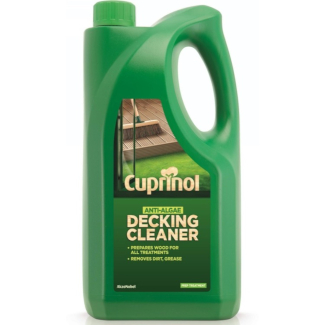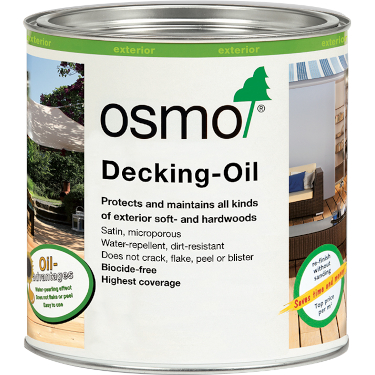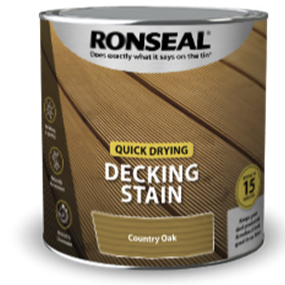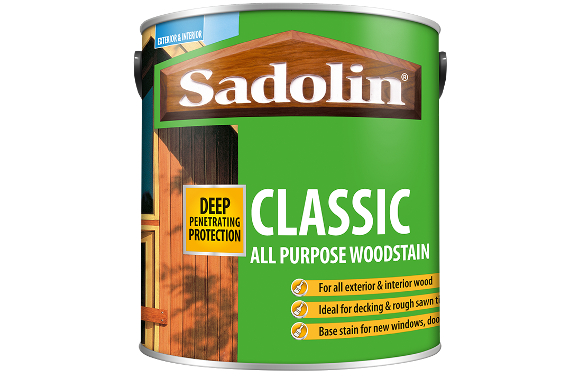In this article we'll walk through the process of preparing and treating your timber decking to keep it looking good for years to come.
As always preparation is the key to success. You'll also need to consider the weather as the deck should be clean and dry and there should be no rain forecast on the day you're planning to apply the decking treatment.
Tools and equipment you may need
- Stiff bristled brush
- Specialist decking cleaner
- Mould remover
- Decking reviver
- Pressure washer
- Long handled broom
- Decking oil or stain
- Dust sheets
- Sandpaper
- Vacuum cleaner
- Paintbrush or paint pad
Preparation
Preparing your decking prior to treatment is an important step in ensuring the longevity of the finish. Proper preparation will help ensure that the treatment adheres correctly, and will ensure that the decking is ready to withstand the elements.
How to clean decking
The first step in preparing your decking is to give it a good clean. This will remove any dirt, debris, and other contaminants that may have built up on the surface.
For cleaning you can either opt to use a specialist decking cleaner, a pressure washer or a good bit of old-fashioned elbow grease!
Regardless of which method you use to clean the deck it's important to treat and remove mould that may be present.
Using a specialist decking cleaner
Use a specialist decking cleaner such as Ronseal Decking Cleaner and Reviver which helps to loosen any dirt or grime that may be present as well as reviving the decking and is perfect way to prepare the deck. It willl also remove any mould present on the deck thus saving you a job!
Another good option is Cuprinol Decking Cleaner which is a powerful decking cleaner for the removal of dirt, algae and mould and makes cleaning your decking easy.

Use a pressure washer to clean the deck
If you don't want to or don't need to use a specialist cleaner on your deck it's possible to use just a pressure washer instead. The steps for cleaing a deck with a pressure washer are fairly straightforward.
Firstly, clear and sweep the deck as well as protecting any plant or shrubs that may be in the way.
Then, using a wide nozzle, with relatively low pressure, work along the grain in long sweeping motions. You may also need to use a stiff brush to loosen stubborn areas of dirt.
Once the deck has been thoroughly cleaned make sure to leave the deck to dry for at least 24h and make sure the deck is completely dry before moving onto the next step.
How to sand decking
If you have smooth decking it's a good idea to give the deck a light sand before treating. This will help to remove any loose particles and prepare the surface for treatment. A sandpaper with a medium to coarse grit is best, and you should sand in the direction of the grain.
Sanding will also help remove any previous coating that may be present which needs to be removed prior to treatment. Sweep or hoover up the all loose dust once the sanding is complete.
If you're changing the type of finish on the deck, for example changing from an oil based finish to a stain then it will be necessary to strip off the old finish first. This can either be done by sanding or in some cases you might need to use a chemical stripper.
Decking treatments
With so many treatments available choosing the right decking treatment might seem like a minefield but fundamentally, it comes down to a choice between a decking oil or stain.
Which one you choose will depend on a variety of factors such as the type of wood your decking is made from, foot fall and the weather conditions it will be exposed to as well as the aesthetic finish you're looking to achieve.
Oil based treatments
Oil based treatments are a great choice for treating a timber deck. Available in a wide range of natural colours they can really enhance the natural look of the timber while providing protection from the rain and UV rays which will help prevent the wood greying.
Decking oil works by penetrating into the grain of the wood replacing the natural oils that are lost over time. Oil based treatments are waterproof, dirt resistant and do not to crack, flake or peel with time. They also tend to be less slippery because the oil penetrates rather than sitting on the surface.

There are a couple of things to bear in mind if you're considering using decking oil. Oil based treatments aren't suitable for certain types of hardwood (e.g. Teak) because the grain of the wood is so dense the oil can't easily penetrate. Also, oil based finished can't be stained or painted over so if you decide that you want a different colour or finish in the future you'll need to strip off the oil first.
That being said once oil based finished are quite easy to maintain. High traffic areas can just be 'patched in'
All in all decking oil is a great choice if you're looking for a durable finish with minimal maintenance.
Decking stains
Available in a varierty of colours and finishes decking stains are a great way to inject a bit of colour to your outside space while still offering a weatherproof and durable finish. Decking stains can also have useful anti-slip properties or additional stain protection so they make a great alternative to decking oil.
Decking stains are either water or solvent based and it's important to understand the differences between the two.
Compared to decking oils, which penetrate into the wood, water based stains tend to sit on the surface of the decking forming a protective coating and in this way they can be thought of more like a varnish or a traditional paint.
 Ronseal Quick Drying Decking Stain can be re-coated in 15 minutes and is naturally slip and stain resistant
Ronseal Quick Drying Decking Stain can be re-coated in 15 minutes and is naturally slip and stain resistantBecause they sit on the surface of the wood water based stains can be more susceptible to flaking and peeling and so require more maintenance overall than their oil based counterparts.
Solvent based stains, such as Sadolin Classic, have characteristics similar to decking oil in that they penetrate deeply into the timber and thus offer exceptional protection against the weather. Solvent based stains are also available in wide range of colours so you can get creative and inject some colour into your outside space.

Sadolin Classic offers the best of both worlds when it comes to staining a deck because it's available in a variety of colours, is cost-effective, offers long lastings protection and can be used on smooth or grooved boards.
Regardless of whether you choose a water or solvent based stain the resulting finish is a tough durable coating suitable for high footfall areas.
How to stain decking
Before applying the stain make sure to read the instructions on the side of the tin. These vary depending on the product you're using so it's always a good idea to read the tin before you start.
Next give the stain a good stir so that all the pigments are mixed together. Before you start painting plan your route so that you don't end up painting yourself into a corner.
For grooved decking it's best to use a large brush to apply the stain. Load up the brush with a liberal amount of the stain and apply directly to the decking. Working methodically paint three or four boards at a time following the direction of the grain. Make sure the stain gets into all the grooves.
If you have a large area of decking or you have back problems consider using a stain applicator mop with a pad. Using a mop means that you don't need to bend over or spend long periods on your hands and knees.
Decking stain applicators tend to work better on smooth decking and it can be much quicker to cover the decking than using a brush.
Once the first coat is dry apply the second coat in the same manner as the first.
How to apply decking oil
As with staining decking oil can be applied either with a brush or applicator pad. The choice will depend on how large the area is you have to treat and the type of decking. For smooth decking an applicator pad will is much faster and more comfortable.
Again, always read the instructions on the side of the tin and take account of any product instructions specific to the product you're using.
Apply a generous amount of oil directly to the decking painting in the direction of the grain. Covering three or four boards at a time is a good rule of thumb and helps to prevent overlap marks.
Once the first coat of oil is dry apply a second coat in the same fashion.
Clean Up
Once the treatment is applied, it’s time to clean up. Make sure to clean any tools or brushes that were used, and dispose of any remaining treatment properly.
Job done!
Preparing and treating your decking is an important step in ensuring that it looks great and lasts for years. With the right preparation and treatment, your deck will be ready to withstand the elements and look great for years to come.

